Influence of Etching Trench on
Abstract
:1. Introduction
2. Materials and Methods
3. Results and Discussion
4. Conclusions
Author Contributions
Funding
Institutional Review Board Statement
Data Availability Statement
Conflicts of Interest
References
- Bi, F.Z.; Barber, B.P. Bulk acoustic wave RF technology. IEEE Microw. Mag. 2008, 9, 65–80. [Google Scholar] [CrossRef]
- Hashimoto, K.-Y. Rf Bulk Acoustic Wave Filters for Communications; Artech House: Norwood, MA, USA, 2009. [Google Scholar]
- Moulet, J.-S.; Pijolat, M.; Dechamp, J.; Mazen, F.; Tauzin, A.; Rieutord, F.; Reinhardt, A.; Defay, E.; Deguet, C.; Ghyselen, B. High piezoelectric properties in LiNbO3 transferred layer by the Smart Cut™ technology for ultra wide band BAW filter applications. In Proceedings of the 2008 IEEE International Electron Devices Meeting, San Francisco, CA, USA, 15–17 December 2008; pp. 1–4. [Google Scholar]
- Pijolat, M.; Loubriat, S.; Queste, S.; Mercier, D.; Reinhardt, A.; Defaÿ, E.; Deguet, C.; Clavelier, L.; Moriceau, H.; Aid, M. Large electromechanical coupling factor film bulk acoustic resonator with X-cut LiNbO3 layer transfer. Appl. Phys. Lett. 2009, 95, 182106. [Google Scholar] [CrossRef]
- Pijolat, M.; Loubriat, S.; Mercier, D.; Reinhardt, A.; Defaÿ, E.; Deguet, C.; Aïd, M.; Queste, S.; Ballandras, S. LiNbO3 film bulk acoustic resonator. In Proceedings of the 2010 IEEE International Frequency Control Symposium, Newport Beach, CA, USA, 1–4 June 2010; pp. 661–664. [Google Scholar]
- Moreira, M.; Bjurström, J.; Katardjev, I.; Yantchev, V. Aluminum scandium nitride thin-film bulk acoustic resonators for wide band applications. Vacuum 2011, 86, 23–26. [Google Scholar] [CrossRef]
- Konno, A.; Sumisaka, M.; Teshigahara, A.; Kano, K.; Hashimo, K.-Y.; Hirano, H.; Esashi, M.; Kadota, M.; Tanaka, S. ScAlN Lamb wave resonator in GHz range released by XeF2 etching. In Proceedings of the 2013 IEEE International Ultrasonics Symposium (IUS), Prague, Czech Republic, 21–25 July 2013; pp. 1378–1381. [Google Scholar]
- Akiyama, M.; Kamohara, T.; Kano, K.; Teshigahara, A.; Takeuchi, Y.; Kawahara, N. Enhancement of piezoelectric response in scandium aluminum nitride alloy thin films prepared by dual reactive cosputtering. Adv. Mater. 2009, 21, 593–596. [Google Scholar] [CrossRef] [PubMed]
- Parsapour, F.; Pashchenko, V.; Chambon, H.; Nicolay, P.; Bleyl, I.; Roesler, U.; Muralt, P. Free standing and solidly mounted Lamb wave resonators based on Al0.85Sc0.15N thin film. Appl. Phys. Lett. 2019, 114, 223103. [Google Scholar] [CrossRef]
- Colombo, L.; Kochhar, A.; Xu, C.; Piazza, G.; Mishin, S.; Oshmyansky, Y. Investigation of 20% scandium-doped aluminum nitride films for MEMS laterally vibrating resonators. In Proceedings of the 2017 IEEE International Ultrasonics Symposium (IUS), Washington, DC, USA, 6–9 September 2017; pp. 1–4. [Google Scholar]
- Akiyama, M.; Kano, K.; Teshigahara, A. Influence of growth temperature and scandium concentration on piezoelectric response of scandium aluminum nitride alloy thin films. Appl. Phys. Lett. 2009, 95, 162107. [Google Scholar] [CrossRef]
- Lakin, K.M.; Belsick, J.; McDonald, J.; McCarron, K. Improved bulk wave resonator coupling coefficient for wide bandwidth filters. In 2001 IEEE Ultrasonics Symposium. Proceedings. An International Symposium (Cat. No. 01CH37263), Proceedings of the 2001 IEEE Ultrasonics Symposium, Atlanta, GA, USA, 7–10 October 2001; IEEE: Piscataway, NJ, USA, 2001; pp. 827–831. [Google Scholar]
- Zhang, H.; Pang, W.; Chen, W.; Zhou, C. Design of unbalanced and balanced radio frequency bulk acoustic wave filters for TD-SCDMA. In Proceedings of the 2010 International Conference on Microwave and Millimeter Wave Technology, Chengdu, China, 8–11 May 2010; pp. 878–881. [Google Scholar]
- Yang, Q.; Pang, W.; Zhang, D.; Zhang, H. A modified lattice configuration design for compact wideband bulk acoustic wave filter applications. Micromachines 2016, 7, 133. [Google Scholar] [CrossRef] [PubMed] [Green Version]
- Chawla, P.; Garg, A.; Singh, S. A high performance multiband BAW filter. Int. J. Inf. Technol. 2019, 11, 779–783. [Google Scholar] [CrossRef]
- Lakin, K.M.; Kline, G.R.; McCarron, K.T. High-Q microwave acoustic resonators and filters. IEEE Trans. Microw. Theory Tech. 1993, 41, 2139–2146. [Google Scholar] [CrossRef]
- Larson, J.D.; Bradley, P.D.; Wartenberg, S.; Ruby, R.C. Modified Butterworth-Van Dyke circuit for FBAR resonators and automated measurement system. In 2000 IEEE Ultrasonics Symposium. Proceedings. An International Symposium (Cat. No. 00CH37121), Proceedings of the 2000 IEEE Ultrasonics Symposium, San Juan, PR, USA, 22–25 October 2000; IEEE: Piscataway, NJ, USA, 2000; pp. 863–868. [Google Scholar]
- Bjurstrom, J.; Vestling, L.; Olsson, J.; Katardjiev, I. An accurate direct extraction technique for the MBVD resonator model. In Proceedings of the 34th European Microwave Conference, Amsterdam, The Netherlands, 12–14 October 2004; pp. 1241–1244. [Google Scholar]
- Feld, D.A.; Parker, R.; Ruby, R.; Bradley, P.; Dong, S. After 60 years: A new formula for computing quality factor is warranted. In Proceedings of the 2008 IEEE Ultrasonics Symposium, Beijing, China, 2–5 November 2008; pp. 431–436. [Google Scholar]
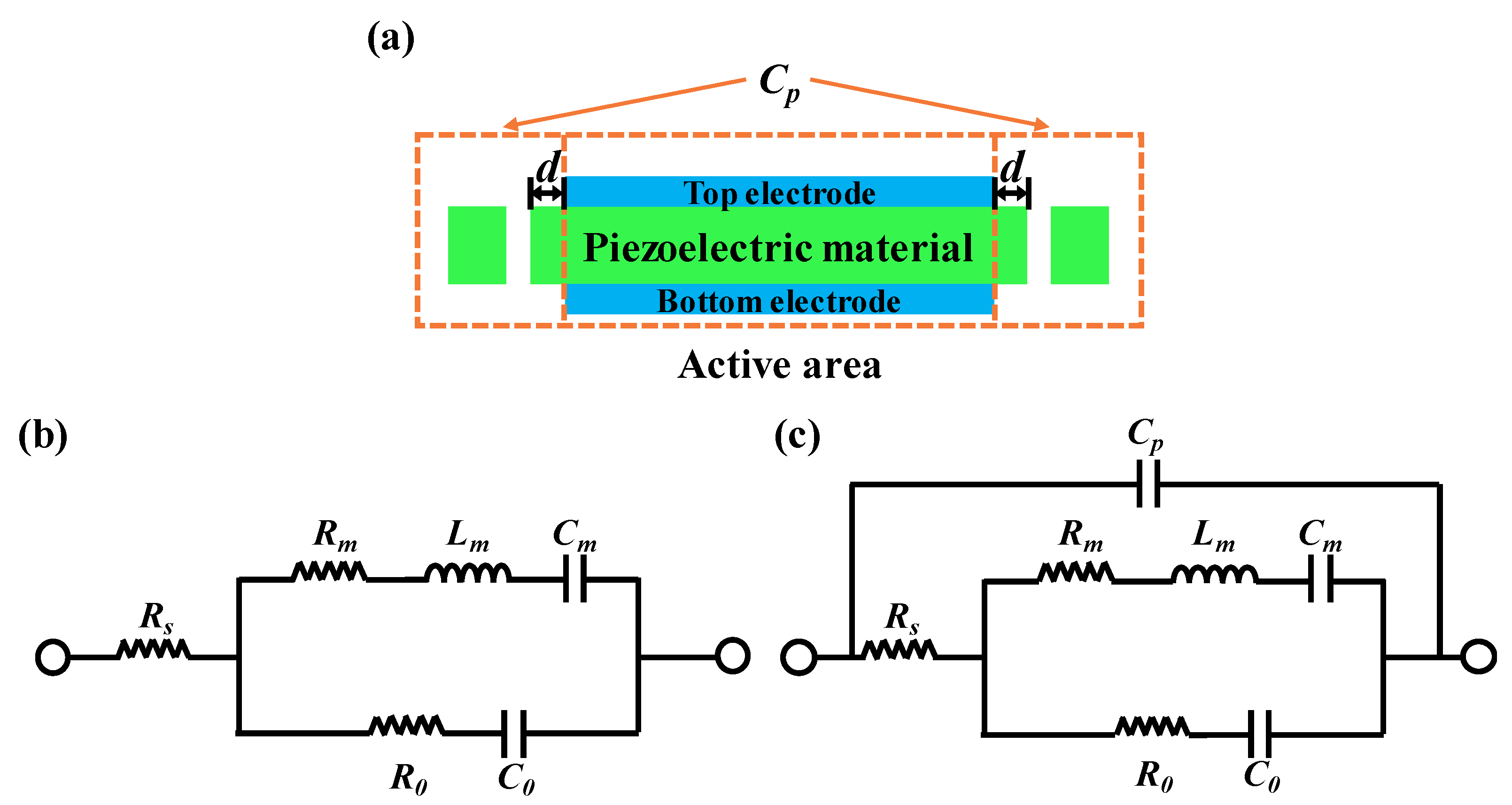
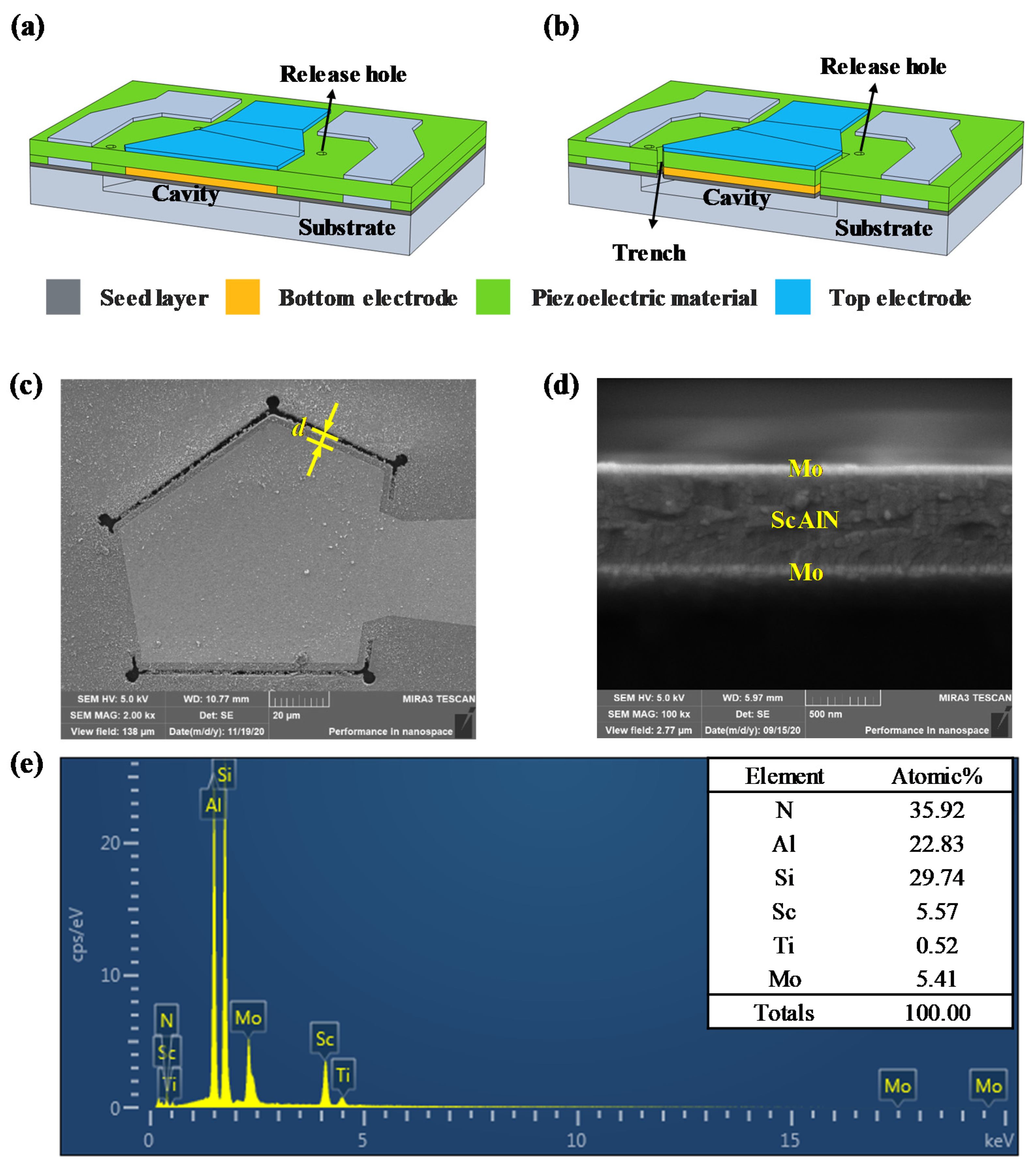

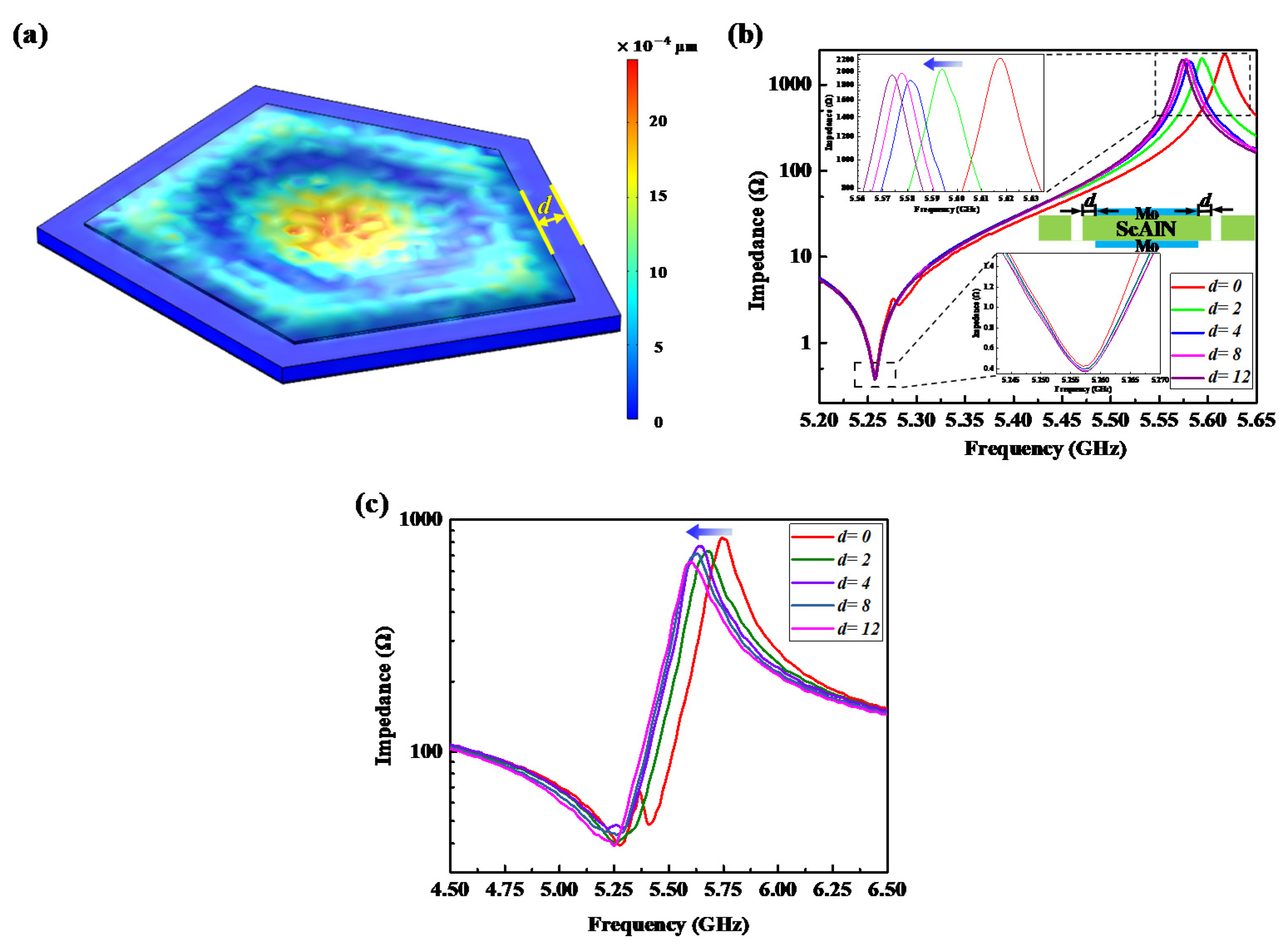
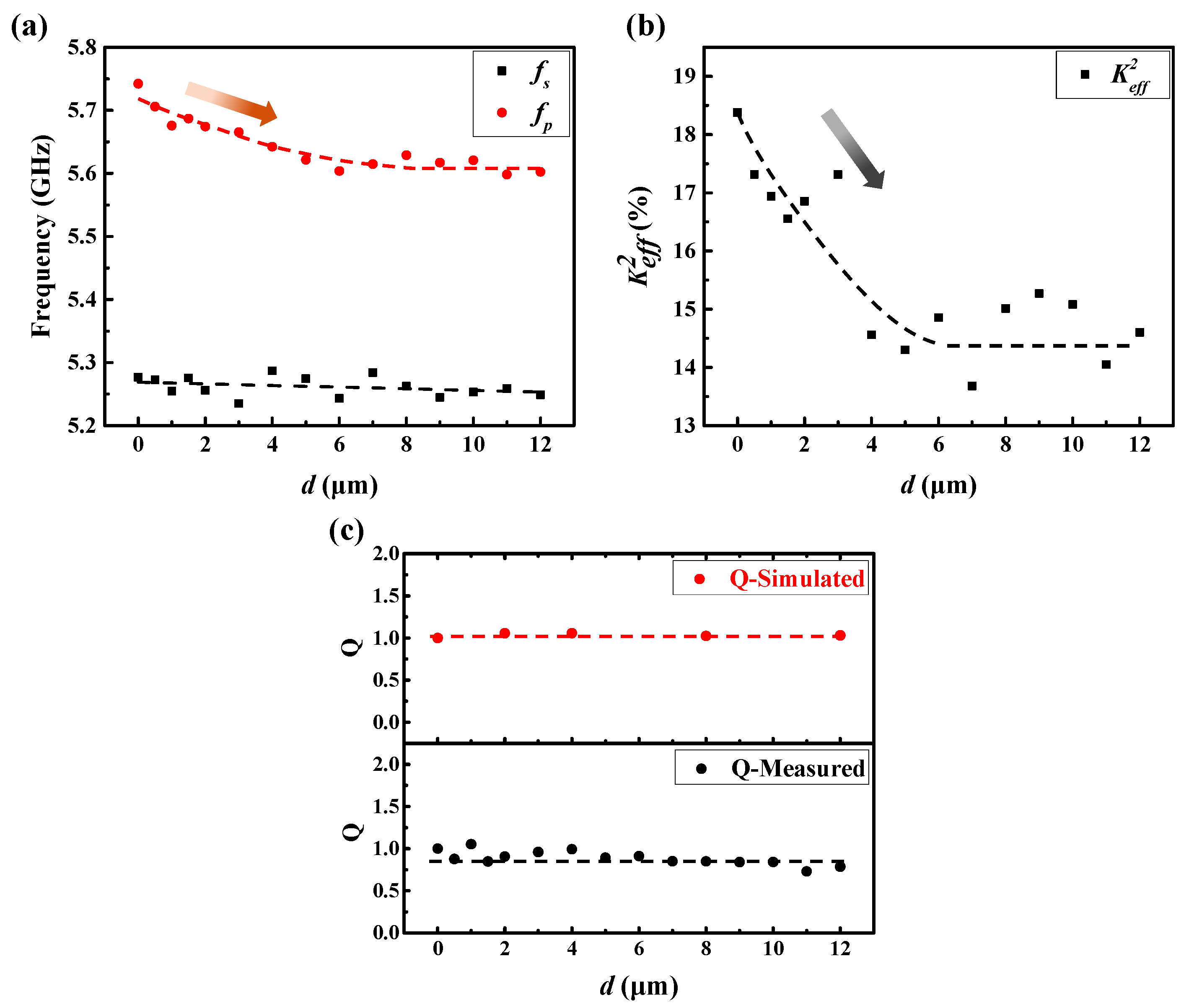
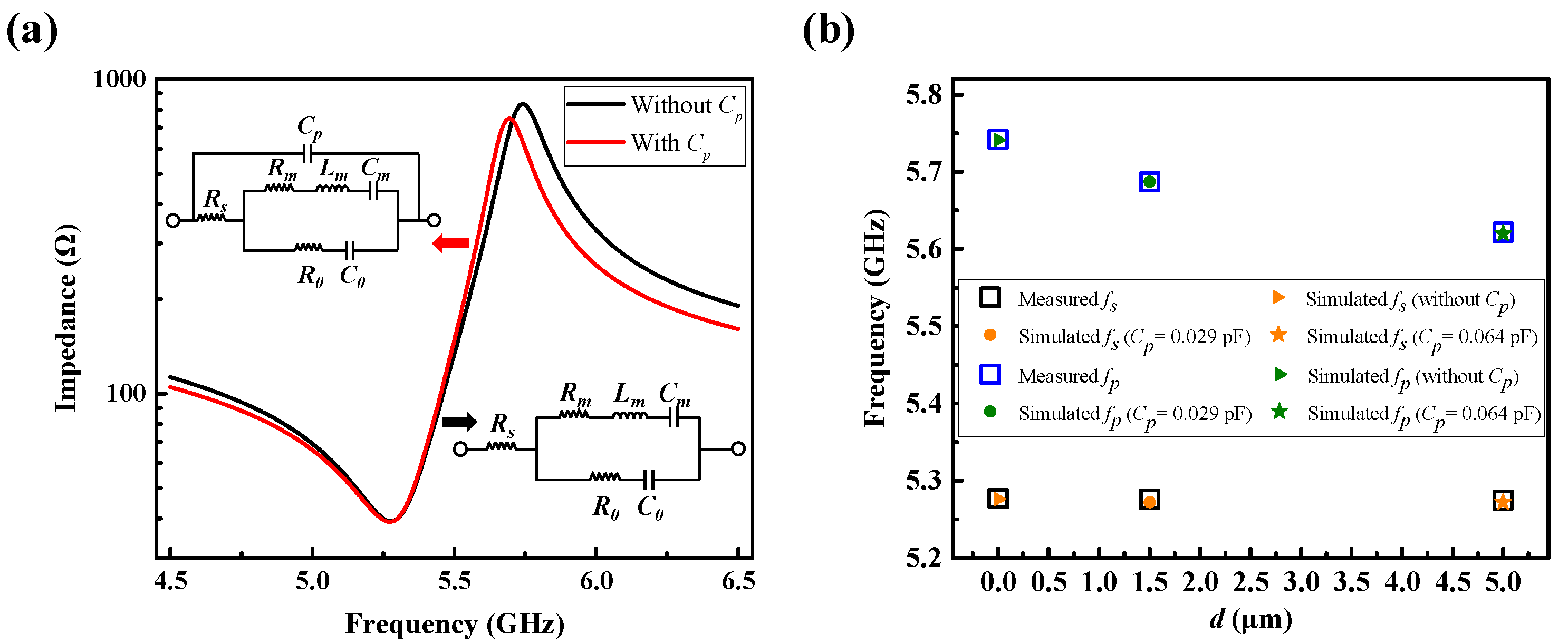
Publisher’s Note: MDPI stays neutral with regard to jurisdictional claims in published maps and institutional affiliations. |
© 2022 by the authors. Licensee MDPI, Basel, Switzerland. This article is an open access article distributed under the terms and conditions of the Creative Commons Attribution (CC BY) license (https://creativecommons.org/licenses/by/4.0/).
Share and Cite
Gao, C.; Zou, Y.; Zhou, J.; Liu, Y.; Liu, W.; Cai, Y.; Sun, C.
Influence of Etching Trench on
Gao C, Zou Y, Zhou J, Liu Y, Liu W, Cai Y, Sun C.
Influence of Etching Trench on
Gao, Chao, Yang Zou, Jie Zhou, Yan Liu, Wenjuan Liu, Yao Cai, and Chengliang Sun.
2022. "Influence of Etching Trench on
Gao, C., Zou, Y., Zhou, J., Liu, Y., Liu, W., Cai, Y., & Sun, C.
(2022). Influence of Etching Trench on





